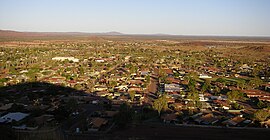Newman, Western Australia
|
Newman Western Australia |
|||||||
|---|---|---|---|---|---|---|---|

Newman residential area
|
|||||||
| Coordinates | 23°21′14″S 119°43′55″E / 23.35389°S 119.73194°ECoordinates: 23°21′14″S 119°43′55″E / 23.35389°S 119.73194°E | ||||||
| Population | 5,478 (2011 census) | ||||||
| Established | 1960s | ||||||
| Postcode(s) | 6753 | ||||||
| Elevation | 544 m (1,785 ft) | ||||||
| Location |
|
||||||
| LGA(s) | Shire of East Pilbara | ||||||
| State electorate(s) | Pilbara | ||||||
| Federal Division(s) | Durack | ||||||
|
|||||||
Newman, originally named Mount Newman until 1981, is a town in the Pilbara region of Western Australia. It is located about 1,186 kilometres (737 mi) north of Perth, and 9 kilometres (5.6 mi) north of the Tropic of Capricorn. It can be reached by the Great Northern Highway. In the 2011 Australian census, its population was 5,478. Newman is a modern mining town, with homes contrasting with the surrounding reddish desert.
The Hickman Crater is 35 kilometres (22 mi) north of Newman.
Newman was established as Mount Newman by Mt. Newman Mining Co. Pty Ltd (a subsidiary of BHP) in 1966 as a company town to support the development of iron ore deposits at nearby Mount Whaleback. The town takes its name from nearby Mount Newman, named in honour of government surveyor Aubrey Woodward Newman, who died of typhoid at Cue on 24 May 1896, while on an expedition from Nannine to the Ophthalmia Range. William Frederick Rudall then took charge of the expedition and named Mount Newman to honour his deceased leader.
Aboriginal occupation of the area extends to around 26,000 years. The Martu people comprise about a dozen language groups that extend across the Gibson and Great Sandy Deserts. The Martu progressively lost their land and nomadic lifestyle as European expansion crept inland from the late 19th Century. Western exploration, the establishment of Christian missions, and gold discoveries at Marble Bar and Wiluna led to Indigenous people moving from their traditional lands.
Typical of company towns, Newman is laid out with a core, where shopping and hotels are located, surrounded by residential areas, with more industrial activities on the outskirts. There is one shopping mall in the town, two shopping plazas, three hotels, and three bars/restaurants outside of those contained in the hotels. One public outdoor pool serves the town's population.
A privately owned railway, the Mount Newman railway, was constructed linking it to Port Hedland which itself was upgraded to handle shipment of the ore to the world market. On 21 June 2001 a train 7.353 km (4.569 mi) long, comprising 682 ore cars and eight locomotives made the Newman—Port Hedland trip and is listed as the world's longest ever train.
...
Wikipedia

